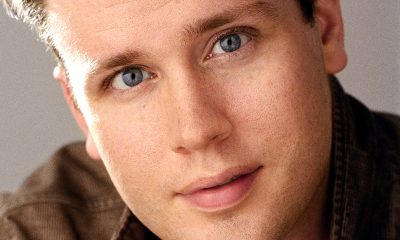a&e features
‘Better’ than ever: an interview with Harvey Fierstein
Beloved actor on pandemic, Broadway history and new biography
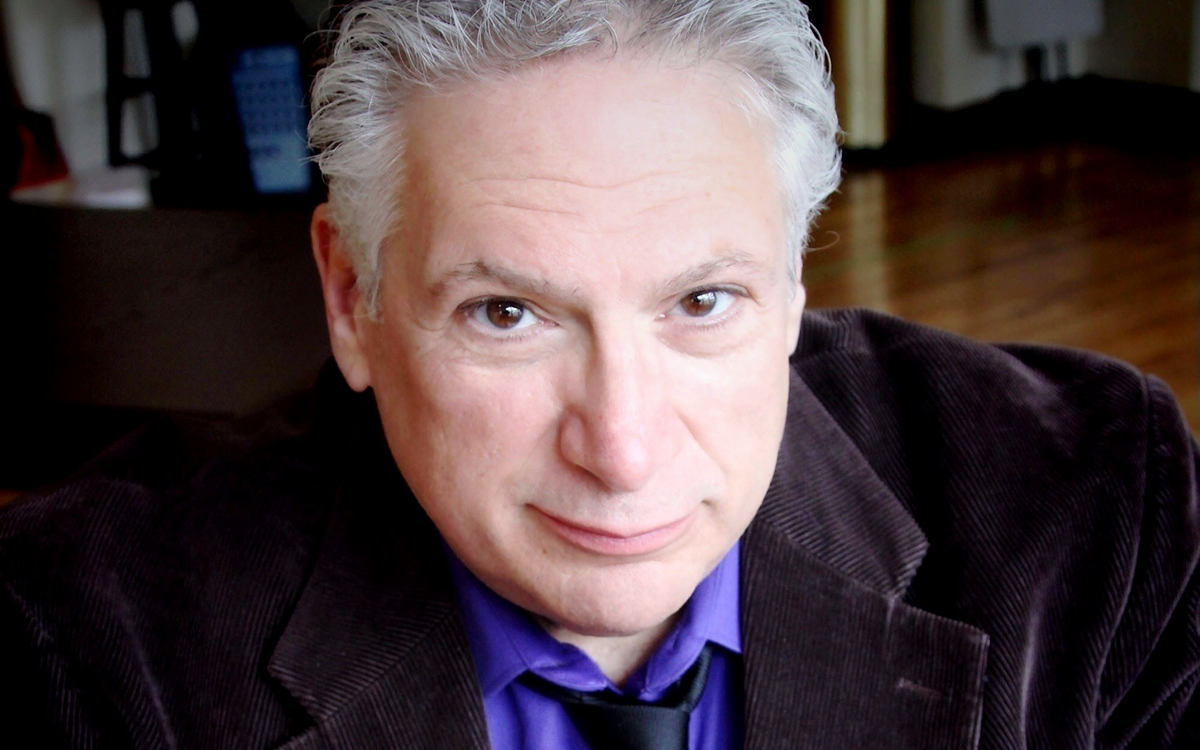
One of the best things about reading a memoir by someone with a distinctive voice – both spoken and written – is that you hear them as your read their book. Let’s face it, award-winning writer and actor Harvey Fierstein qualifies as someone who has a distinctive voice and while reading his revelatory memoir, “I Was Better Last Night” (Knopf, 2022), you’d swear he was in the room with you, dishing away. Harvey was gracious enough to make time for an interview shortly before the book’s March 2022 publication date.
BLADE: Harvey, why was now the time to write your memoir, “I Was Better Last Night,” and does having a milestone birthday (70) in 2022 have anything to do with it?
HARVEY FIERSTEIN: What’s really funny is that so many sources, if you look online, have my birthday as 1954, even though it’s actually 1952. The reason is that when I turned 22, my friend Eric Conklin, who directed the original production of “Torch Song,” said “You should tell everybody you’re turning 21.” I said, “Why?” He said, “Because if you lie when you’re older, nobody believes it. But if you start at 21, who the fuck’s going to care!” That year, I moved my birthday to ‘53. The next year, we decided we’d do it again. But I never took it seriously. Things just get picked up by this one or that one. I think it was in New York magazine that they got the facts wrong and said my parents were Eastern European immigrants. They were actually third-generation Americans. But it got picked up by everyone and everywhere it said I was the son of Eastern European immigrants. My mother was born in Brooklyn and my father was born in the Catskills. So, I wrote the book, and there’s a fact checker, of course. Every time I mentioned my age he sent back a note, “Wikipedia says you were born in ‘54. This one says you were born in ’54,” I had to keep saying, “Why would I lie and make myself older? I’d only make myself younger!” It’s another one of those examples of why you should never lie. I am indeed as old as the mountains. So, did I write the memoir because of the birthday? No. Like everybody else in the fucking world, this pandemic hit. I was a very good boy. I sat down and did all the work on my desk. At that time, we were supposed to be doing a production of “Bye Bye Birdie” at the Kennedy Center. I finished the rewrites on that. I had rewritten “Funny Girl,” which was done in London and then went on tour in England, and we were bringing it to Broadway. I wanted to make some more changes to it, so I got all those changes done. “Kinky Boots” was sold to cruise ships, so I had to do an adaptation, a shortening of the show, as I had already done for “Hairspray” and other shows. That was off my desk and done. I’m working on a new musical with Alan Menken and Jeff Feldman, the guys I wrote “Newsies” with.
BLADE: Yes, I read about that in the book.
FIERSTEIN: So, I was all caught up with that. Basically, I was done. Then I sat down and, as I say in the book, I make quilts. I owed a couple of quilts as gifts. I went down to my little sewing room and I made seven quilts in a row [laughs]. Usually, I turn out one a year. Everybody got their birthday quilts, their wedding quilts, whatever it was that was owed. I had cleared my desk and we were still in the pandemic. Then my agent said to me, “Why don’t you write your memoir?” I said, “Because I don’t write sentences.”
BLADE: You wrote the children’s book. That has sentences.
FIERSTEIN: But that’s kid sentences. I’ve written op-eds, but for that you just have to get the voice of Edward R. Murrow in your head or something like that. That’s like writing dialogue, as well. All of a sudden, you’re Aaron Sorkin. I thought, “What the fuck? I’ve got a computer. Let me try.” I wrote four chapters, and I sent them to my agent. She said, “This is great!” She sent the chapters out to I think nine publishers, and eight of the nine made offers.
BLADE: There are numerous powerful moments throughout the book. Without giving away too much…
FIERSTEIN: Oh, go ahead, give it away! I already know what happens.
BLADE: But I don’t want to spoil it for the readers.
FIERSTEIN: That’s right. Goddammit.
BLADE: Chapter 57 contains one of the most emotional sequences involving your parents. Would it be fair to say that writing the book was a cathartic experience?
FIERSTEIN: Yes, the whole thing really is. When I started, I asked Shirley MacLaine because she’s written 300 books about her 700 different lives. She said, “Write what you remember because your brain has a way of editing, and it will give you what you need for this book. You’ll remember things for other books and other things, but write what you remember and just be true to what comes up.” I said, “Even about other people?” She said, “Yes. When you’re writing about other people, you’re really writing about yourself. Just trust that.” That’s what I did. There were hundreds of stories that I could have told. I just tried to sort of follow a line of thought and let it be.
BLADE: That’s interesting because the chapters in “I Was Better Last Night” are presented in chronological order, beginning in 1959 and concluding in 2022. Is that how they were written?
FIERSTEIN Yes, I wrote it exactly as it is. As you say, that particular chapter, I knew was coming because I knew what happened to bring that memory back. I’m trying to say it as you said, to not give it away. What happened between me and my brother, when he sat down to watch the last revival of “Torch Song.” My editor was incredibly gentle with me. Now and then he’d say, add more here or there. But the only real note that I got from him was he wanted to move that story into chronological order since the rest of the book is. I said, “No. That’s in emotional order.”
BLADE: It needed to be where it was.
FIERSTEIN: Exactly! Most celebrity autobiographies begin “I was a kid and I saw a show and I said, ‘I wanna be a star, too!’” Which is obviously not my story. I never wanted to be in show business. I didn’t want to be a writer. I didn’t want to be an actor or a drag performer. It was not my dream at all. That’s why it was so important to do it chronologically. I wanted to show how I lived my life being true to the moment I was in.
BLADE: In “I Was Better Last Night” you take readers on a journey through modern theater, from The Gallery Players and La Mama to off-Broadway and Broadway. With that in mind, would you agree that in addition to being a memoir, the book also functions as a theater history lesson?
FIERSTEIN: I guess it does. I have certainly been told that by a bunch of people who’ve read the book. When I was talking to Patti LuPone about it, she said, “Geez, I wish I had done what you did. She came through theater school and right into the legitimate, not through the experimental. As I say in the book, I came from an art school, so I always approached it as an art. Theater was part of an art movement, and I got involved because I wanted to meet Andy Warhol. Little did I know they would put me in drag. I guess there is a history there. Certainly, when I look around me, and I look at the people that I grew up with – Kathleen Chalfant and Obba Babatundé — and, of course, La Mama became something bigger. There were lots of others. Meeting Matthew (Broderick) at 18, or Estelle Getty who was a housewife from Bayside, Queens. She wouldn’t even admit she was from Bayside. She told everybody she was from Long Island [big laugh]. I said, “Estelle! Bayside is in Queens. Shut up!” What is history? After all, history is just day after day after day after day. I did start, as a baby, in this experimental theater. I wish that experimental theater still really existed. There were a few of us that I would say destroyed off-off-Broadway. I think greed is what destroyed off-off-Broadway. I think what happened was when people saw Tom O’Horgan make it, when “Hair” became a hit, that had a lot of people going, “Where’s my ‘Hair’?”
BLADE: But don’t you think that experimental theater might exist in cities where it’s a little more affordable to do that kind of thing? Say, Austin, Texas.
FIERSTEIN: There will always be experimental theater. It’s just, how is it looked at? Is the government funding there for it? I hear a lot of people saying, “Let’s not waste money on theater.” “Torch Song Trilogy” wouldn’t have been what it was if not for a government grant. I don’t know if you know this, but I just gave a grant to the New York Public Library at Lincoln Center to build a theater laboratory because rehearsal space is incredibly expensive in New York and almost impossible to find. David Rockwell is designing it and I’m hoping it’ll be open in two years. I tell a story in the book about how years ago we were rehearsing up at the YMCA, and the director just disappeared and left us with the bill for the rehearsal room. If I can leave a rehearsal room behind… Lin-Manuel (Miranda) developed “Hamilton” in the basement of the Drama Book Shop. For my shows, I used the basement of La Mama which was this small space, but big enough for us to rehearse and develop what we needed to do. I even did a couple of shows down there.
BLADE: Chapters 19 through 22 give readers insight into the inspiration for and the writing of “Torch Song Trilogy” and then much later you write about the recent revival with Michael Urie. What was it like to revisit the creation and the revision of “Torch Song Trilogy?”
FIERSTEIN: They’re your children, so they never really leave you. You may not think about them in the same way all the time, but they don’t leave you. You ask a mother about her son when he was six, and she can tell you a story about that time. It doesn’t mean you live with those stories every day. But they’re always there. Unfortunately, as you get older and people die on you, you remember them, or you go back to those stories time and again to remember how you all met and all that. With something like Torch Song, which is so much a part of my life, there was no real shock to going back and looking at that stuff again. Seeing Michael do it was not a shock either, because I cast all of my understudies. The show ran on Broadway for five years, but I didn’t play it all five years. There were other Arnolds and I saw all of them. There were matinee Arnolds, and then we had a bus and truck tour, and a regular tour. I saw all of those guys play it. I saw it in London with Tony Sher, who died a few weeks ago. He won the Olivier for “Torch Song.” Writing a memoir is not a time to blame other people [laughs]. When you’re writing plays, it is.
BLADE: I’m so glad you said that because one of the things that I think will strike readers about “I Was Better Last Night” is the brutal honesty with which you write about alcoholism and sobriety, as well as your suicide attempt. What do you hope readers will take away from that?
FIERSTEIN: There’s a certain point when you’re writing something like that…I don’t really care [laughs]. I needed to tell the truth and you hope that the truth will do good. When you’re writing fiction, you care more about how it’s read and what somebody gets out of the fiction. When you’re writing non-fiction, it’s like, “This is what happened, like it or not, Cookie.” The only hope is that I hope you know I’m telling it the best I can and being truthful. Because the truth does affect people, that I know. When you’re writing drama, you are manipulating an audience, and a story, and emotions. When I was writing the book, of course, there’s still an art to it, but I’m not turning away from something because it’s not comfortable. I’m going to say it. If somebody thinks I’m an asshole, let them think I’m an asshole. You read the book, and thank you very much for doing so.
BLADE: That’s my job!
FIERSTEIN: You see in the book that I don’t have an answer for my own gender. Had I been born in 1980, instead of 1952, would I be a woman now? I don’t know. I don’t have those answers. I don’t have the luxury of being born in a different society. The first (trans) person I knew was Christine Jorgensen, who died owing me money, that bitch [laughs]. When I was writing the book, I was going through photographs. There’s a picture in the book of me and Marsha P. Johnson and Jon Jon marching in a Gay Pride march. I put that picture up and somebody wrote to me telling me about Marsha, like you should know who this person was. I was like, “What are you talking about? This was a friend of mine!”
BLADE: Thank you for mentioning pictures. I live four blocks south of Wilton Manors in Fort Lauderdale. In the book you include a photo of the WiltonArt.com street sign that features a quote by you. What does it mean to you to be immortalized in this way?
FIERSTEIN: While it’s very flattering, another place I looked had it that Walt Whitman said it! With one hand, you’re flattered, and with the other, you’re slapped across the face.
BLADE: At least they got the attribution right in Wilton Manors.
FIERSTEIN: That’s lovely, it really is lovely. It’s a lovely thing to see something link that. I was watching some interview with Billy Porter and as if by accident, they walked down the block where there was a mural on the side of a building of his portrait. As if, “Oh, I didn’t know that was there!” You sort of laugh, like, yeah, right! You brought a film crew because you didn’t know your picture was there on the wall [laughs]. That sort of stuff of celebrity is always funny. Especially when you have friends who are famous and you try to just be human beings together, but then you go out in public, and you realize that they mean a whole other thing to the public than to you.
a&e features
Queer TV anchors in Md. use their platform ‘to fight for what’s right’
Salisbury’s Hannah Cechini, Rob Petree are out and proud in Delmarva
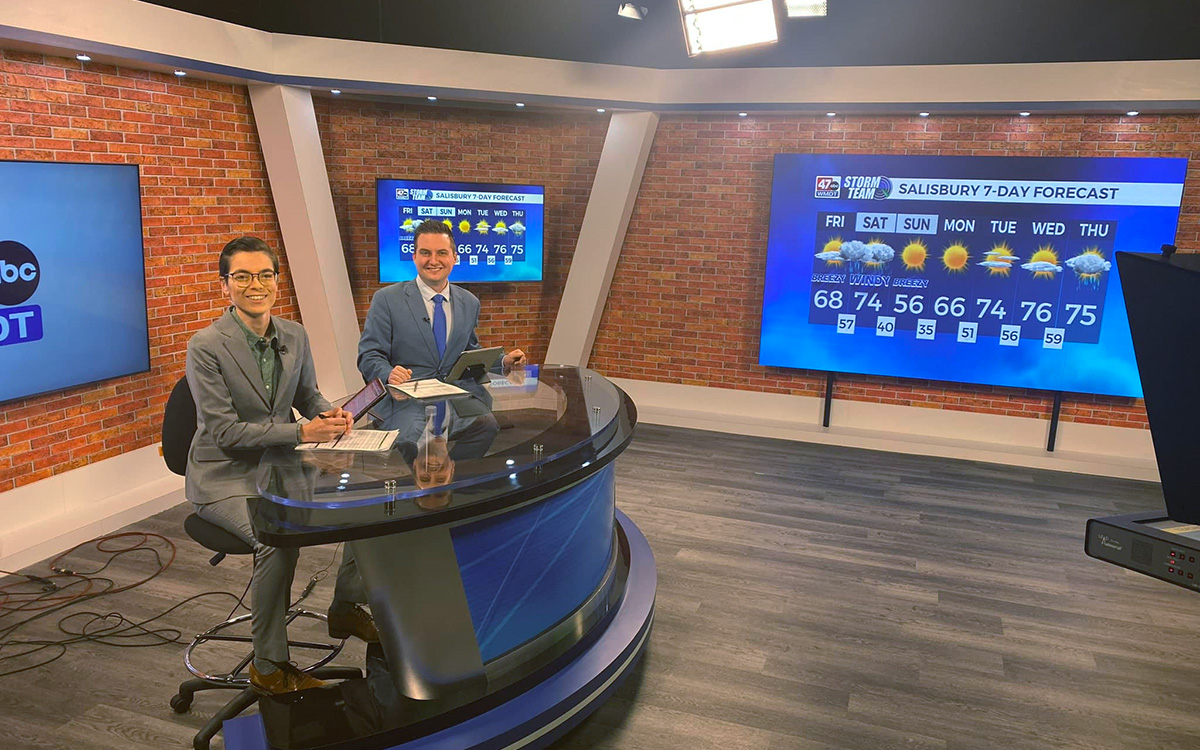
Identity can be a tricky thing for journalists to navigate. The goal of the job is to inform the public with no bias, but this is difficult, if not impossible, to do in practice. Everything from your upbringing to the books you read can impact how you view and cover the world. But sometimes these factors can help shine a light on an underrepresented community or issue.
Two broadcast journalists in Salisbury, Md., are using the subtle, yet impactful choice of sharing their queer identities to strengthen their reporting and connection to the community.
Hannah Cechini, who is non-binary, and Rob Petree, who is gay, co-host the 5:30-6:30 p.m. newscast for WMDT 47. They are the only known anchor team that are not only both queer, but also open out about their identities on air and, as Petree put it, “always use [their] platform and power that [we] have to fight for what’s right.”
Cechini’s passion for journalism played an important role in the discovery of their gender identity. They knew they were meant to be in the newsroom before they figured out they were non-binary.
“I was doing this job before I started to identify as non-binary,” Cechini told the Blade. “I’d always watch the evening news with my dad growing up and thought it was the coolest thing. And throughout high school, I worked on the school paper.”
After graduating from Suffolk University in Boston, Cechini’s passion for journalism only grew as they began to work in the world of news media, eventually ending up in Salisbury. As they honed their writing, editing, and anchoring skills at WMDT, Cechini also started to take an introspective look into their gender identity.
A little more than two years ago Cechini came out as non-binary to their coworkers in the newsroom and was met with support all around. “It was definitely smoother than I anticipated,” they said.
“It is very freeing to be able to do this job as a non-binary person because I haven’t really seen much of that representation myself.”
Petree, on the other hand, knew he was gay right around the same time he became interested in news media, at age 14. He started working for his high school news show and used it as a way to be open about his sexuality rather than hide it.
“I broke into broadcasting doing the morning announcements,” he said. “I did the weather and started doing a segment called issues and insights,” Petree said, explaining his introduction to the news. Eventually, students would ask him questions about his sexuality after seeing him on the school TV. “It had gotten to the point in school, that if you’re going to come up and ask me if I’m gay, well shit, I’m going to tell you!”
To him, this was the exact reason he had come out. Petree wanted to motivate others to live honestly.
“There are a lot of people who will spend most of their lives not being out so if they can see someone like me, who’s out and proud doing his thing, so to speak, then maybe that’s the inspiration for them,” Petree said. “To search their own soul, find out who they are, and live their full life.”
Petree explained that he got his start in a space that was not always welcoming to his queerness. This tested the delicate balance between being a journalist and holding your identity close.
“I’ve always been out and it was a challenge because I got my start in conservative talk radio,” Petree said. “I’m going to be honest, some of the things I heard from people I’ve worked with, from the callers to the radio stations were absolutely abhorrent. But I never let it discourage me. It made me work that much harder.”
Cechini highlighted the same sentiment when explaining why it’s important to have out LGBTQ figures in news media. They want to show everyone that it is possible to be openly queer and successful.
“I just think that representation matters because if ‘Joe,’ who’s never seen a transgender person before, sees a transgender person or a non-binary person, doing a job that they’ve only ever seen straight cis people doing before, it kind of creates that understanding or bridges that gap,” Cechini said. “It’s like, ‘OK, maybe they’re not that different from me.’ And that facilitates being able to connect among different communities.”
Both Cechini and Petree agree that having a queer coworker has made their bond stronger.
“It’s great to have someone else next to me who I can relate to and work alongside,” Petree said. “And they’re a joy to work with, they really are. There is a tremendous amount of things that we relate to together — like we both share and have the same affinity for Lady Gaga,” he said laughing. “Although they’re more of a Lady Gaga fan than I am.”
“Hannah is a tremendous journalist who really goes out of their way to make sure that the stories that they do are on point 100% of the time,” he added. “They’ve been great to work with and to learn from and to grow alongside. I’m very happy to have them as my co-anchor.”
Cechini explained that the relationship between two co-anchors can make or break a newscast, and having Petree as their partner on air is a major part of the show’s success.
“Co-anchoring is not just the relationship that you have on camera,” Cechini said. “It’s really, really important to have a good relationship with your co-anchor off-camera as well because you have to have a level of trust between you.”
Cechini continued, saying that this relationship is crucial to working together, especially when things don’t go as planned.
“Not everything always goes to script,” they said. “Sometimes you have to be able to work together without even really talking to each other and just kind of know what to do. When you have a relationship like that with someone who identifies similarly to you or has had similar life experience, I think that just only strengthens that [relationship].”
Although they have had similar experiences being from the LGBTQ community, Petree said it was a change for him to use “they/them” pronouns on air.
“Prior to working with Hannah, I’ve never worked with a non-binary individual who went by the pronouns ‘they/them,’” Petree said. “It was new for me to not use traditional pronouns on air, but I can say that I have never misgendered them on air and never will. You get conditioned to using traditional pronouns and it’s easy to make that mistake, but I never have.”
At the end of the day, they both explained, it is about doing the job right. For the duo, a part of that is understanding the diversity of people and issues in the community.
“When you come from a more marginalized community, I think that kind of helps to inform you a little better as a journalist because you have a better understanding of what it’s like to be ‘the other guy,’” Cechini said.
“Our talent and our drive for journalism speaks for itself,” Petree said. “And that resonates with people. Have we shown ourselves to be an inspiration to the LGBTQ+ community here in Delmarva? Yes, we have. And that’s something that I’m proud of.”
The primetime nightly newscast with Hannah Cechini and Rob Petree airs weeknights from 5:30-6:30 p.m. on ABC affiliate WMDT 47.
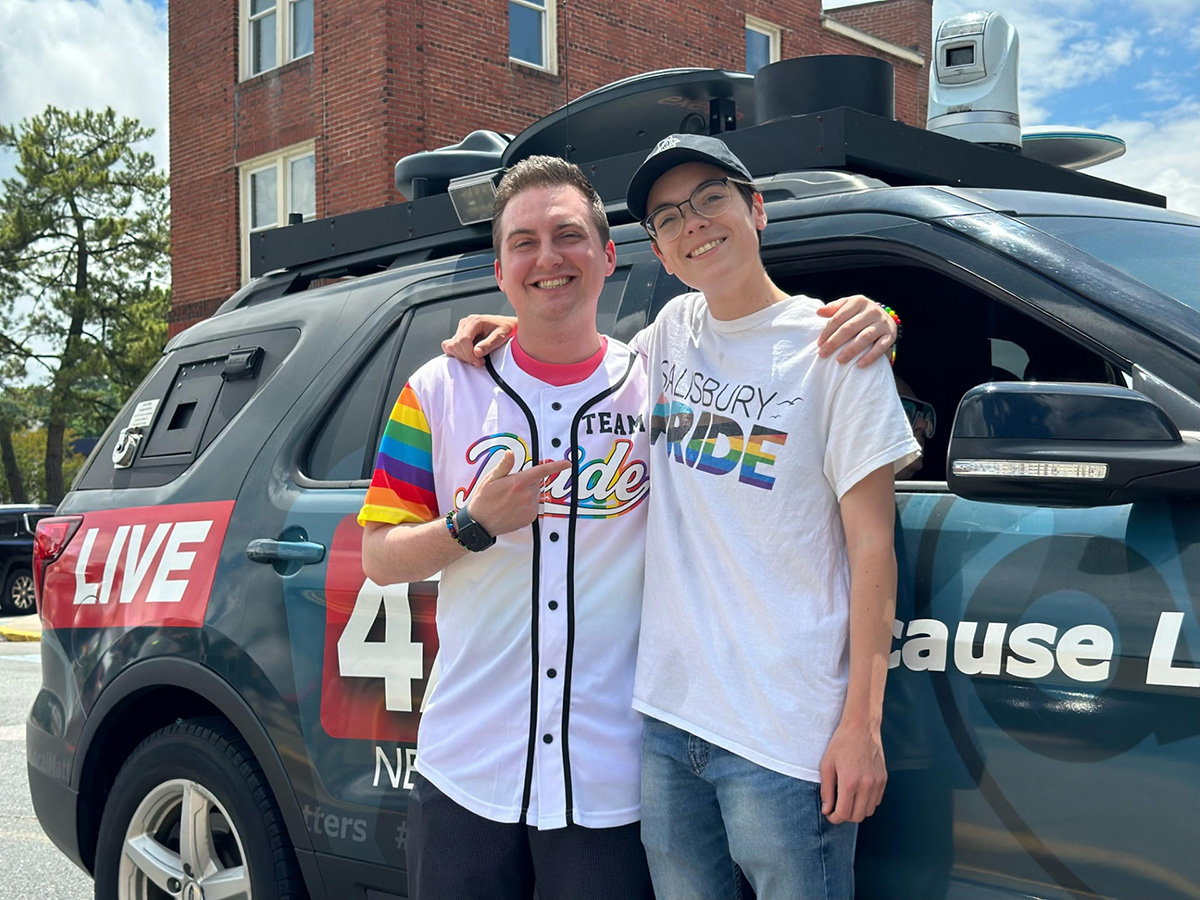
a&e features
‘Queering Rehoboth Beach’ features love, loss, murder, and more
An interview with gay writer and historian James T. Sears
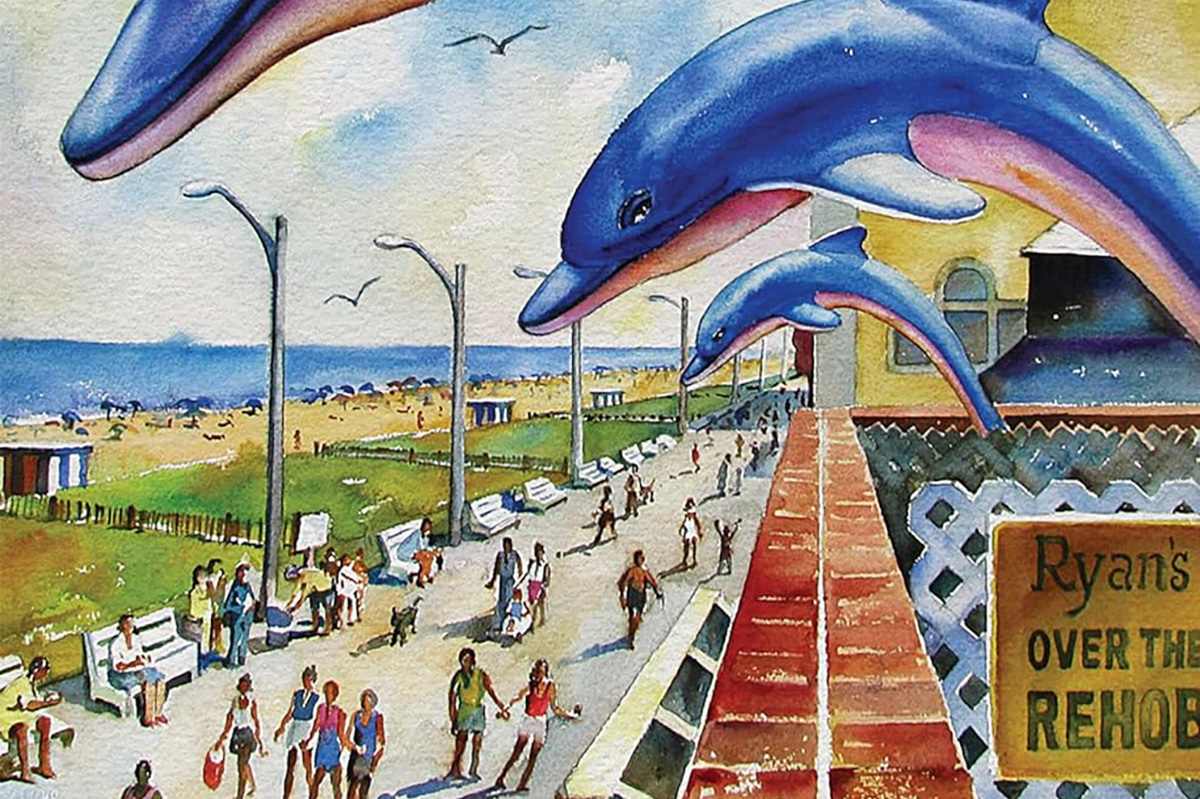
James T. Sears book talk
Saturday, June 29, 5 p.m.
Politics & Prose
5015 Connecticut Ave., N.W.
When it comes to LGBTQ summer destinations in the Eastern time zone, almost everyone knows about Provincetown, Mass., Fire Island, N.Y., and Key West, Fla. There are also slightly lesser known, but no less wonderful places, such as Ogunquit, Maine, Saugatuck, Mich., and New Hope, Pa. Sandwiched in between is Rehoboth Beach, Del., a location that is popular with queer folks from D.C., Maryland, Virginia, Pennsylvania, and New Jersey. The dramatic and inspiring story of how Rehoboth Beach came to be what it is today can be found in gay historian James T. Sears’s revealing new book “Queering Rehoboth Beach: Beyond the Boardwalk” (Temple University Press, 2024). As educational as it is dishy, “Queering Rehoboth Beach” provides readers with everything they need to know (and possibly didn’t realize they needed to know) about this fabulous locality. Sears was kind enough to make time to answer a few questions about the book.

WASHINGTON BLADE: James, it’s been a few years since I’ve interviewed you. The last time was in 1997 about your book “From Lonely Hunters to Lonely Hearts: An Oral History of Lesbian and Gay Southern Life.” At the time, you were living in Columbia, S.C. Where are you currently based, and how long have you been there?
JAMES T. SEARS: It has been great reconnecting with you. After that book, we moved to Charleston, S.C. There I wrote several more books. One was about the Mattachine group, focusing on one largely misunderstood leader, Hal Call. Another book shared reminisces of a 90-year-old gentleman, the late John Zeigler, interweaving his diaries, letters, and poetry to chronicle growing up gay in the South at the turn of the last century. From there I moved to Central America where I chronicled everyday queer life and learned Spanish. We returned several years ago and then washed up on Rehoboth Beach.
BLADE: In the introduction to your new book “Queering Rehoboth Beach: Beyond the Boardwalk” (Temple University Press, 2024), you write about how a “restaurant incident” in Rehoboth, which you describe in detail in the prologue, became a kind of inspiration for the book project. Please say something about how as a historian, the personal can also be political and motivational.
SEARS: I want to capture reader’s interest by personalizing this book more than I have others. The restaurant anecdote is the book’s backstory. It explains, in part, my motivation for writing it, and more crucially, introduces one meaning of “queering Rehoboth.” That is, in order to judge this “incident”—and the book itself—we need to engage in multiple readings of history, or at least be comfortable with this approach. I underscore that what is accepted as “history”—about an individual, a community, or a society—is simply a reflection of that era’s accepted view. Queering history challenges that consensus.
BLADE: Who do you see as the target audience for “Queering Rehoboth Beach?”
SEARS: Well, certainly if you have been to Rehoboth or reside there, this book provides a history of the town—and its queering—giving details that I doubt even locals know! Also, for those interested in the evolution of other East Coast queer resorts (Ptown, Fire Island, Key West) this book adds to that set of histories. My book will also be of interest to students of social change and community organizing. Most importantly, though, it is just a good summer read.
BLADE: “Queering Rehoboth Beach” features numerous interviews. What was involved in the selection process of interview subjects?
SEARS: I interviewed dozens of people. They are listed in the book as the “Cast of Narrators.” Before these interviews, I engaged in a systematic review of local and state newspapers, going back to Rehoboth’s founding as a Methodist Church Camp in 1873. I also read anecdotal stories penned by lesbians and gay men. These appeared in local or regional queer publications, such as Letters from CAMP Rehoboth and the Washington Blade. Within a year, I had compiled a list of key individuals to interview. However, I also interviewed lesbians, gay men, transgender individuals, and heterosexuals who lived or worked in Rehoboth sometime during the book’s main timeframe (1970s-2000s). I sought diversity in background and perspective. To facilitate their memories, I provided a set of questions before we met. I often had photos, letters, or other memorabilia to prime their memories during our conversation.
BLADE: Under the heading of the more things change, the more they stay the same, the act of making homosexuality an issue in politics continues to this day. What do you think it will take for that to change?
SEARS: You pose a key question. Those who effectuated change in Rehoboth — queers and progressive straights — sought common ground. Their goal was to integrate into the town. As such, rather than primarily focus on sexual and gender differences, they stressed values held in common. Rather than proselytize or agitate, they opened up businesses, restored houses, joined houses of worship, and engaged in the town’s civic life.
To foster and sustain change, however, those in power and those who supported them also had to have a willingness to listen, to bracket their presuppositions, and to engage in genuine dialogue. Violent incidents, especially one on the boardwalk, and the multi-year imbroglio of The Strand nightclub, gradually caused people to seek common ground.
That did not, however, come without its costs. For some — long separated from straight society — and for others — unchallenged in their heteronormativity — it was too great of a cost to bear. Further, minorities within the queer “community,” such as people of color, those with limited income, and transgender individuals, never entered or were never invited into this enlarging public square.
The troubles chronicled in my book occurred during the era of the “Moral Majority” and “Gay Cancer.” Nevertheless, it didn’t approach the degree of polarization, acrimony, fake news, and demagoguery of today. So, whether this approach would even be viable as a strategy for social change is debatable.
BLADE: In recent years, there has been a proliferation of books about LGBTQ bars, a subject that is prominent in “Queering Rehoboth Beach.” Was this something of which you were aware while writing the book, and how do you see your book’s place on the shelf alongside these other books?
SEARS: Queering heterosexual space has been a survival strategy for generations of queer folks. These spaces — under-used softball fields, desolate beaches, darkened parks, and out-of-the-way bars — are detailed in many LGBTQ+ books, from the classic, “Boots of Leather, Slippers of Gold,” to the recently published “A Place of Our Own” and “The Bars Are Ours.” Of course, these spaces did not encompass the kaleidoscope of queer life, but they provide us a historical gateway into various segments of a queer community and culture.
This was certainly true for my book. Unsurprisingly, until The Strand controversy, which began in 1988, all of Rehoboth’s queer bars were beyond the town limits. There were, however, homosexual watering holes in the liminal sexual space. For instance, you had the Pink Pony on the boardwalk during the 1950s and the Back Porch Café during the 1970s. So, in this sense, I think “Queering Rehoboth Beach” fits well in this ever-enlarging canon of queer history.
BLADE: As one of the most pro-LGBTQ presidents in U.S. history, how much, if it all, did the Biden Delaware connection have to do with your desire to write “Queering Rehoboth Beach?”
SEARS: It is just a coincidence. Interestingly, as I was researching this book, I came across a 1973 news story about Sen. Joe Biden speaking at a civic association meeting. One of the 30 or so residents attending was James Robert Vane. The paper reported the senator being “startled” when Vane questioned him about the ban on homosexuals serving in the U.S. civil service and military. Uttering the familiar trope about being “security risks,” he then added, “I admit I haven’t given it much thought.” In Bidenesque manner, he paused and then exclaimed, “I’ll be darned!”
Biden was a frequent diner at the Back Porch Café, often using the restaurant’s kitchen phone for political calls. Like the progressives I spoke about earlier, he had lived in a heteronormative bubble—a Catholic one at that! Yet, like many in Rehoboth, he eventually changed his view, strongly advocating for queer rights as Vice President during the Obama administration.
BLADE: How do you think Rehoboth residents will respond to your depiction of their town?
SEARS: Well, if recent events are predictive of future ones, then I think it will be generally positive. My first book signing at the locally owned bookstore resulted in it selling out. The manager did tell me that a gentleman stepped to the counter asking, “Why is this queer book here?”— pointing to the front table of “Beach Reads.” That singular objection notwithstanding, his plan is to keep multiple boxes in stock throughout the summer.
BLADE: Over the years, many non-fiction and fiction books have been written about places such as Provincetown, Fire Island, and Key West. Is it your hope that more books will be written about Rehoboth Beach?
SEARS: My hope is that writers and researchers continue to queer our stories. Focusing on persons, events, and communities, particularly micro-histories, provides a richer narrative of queer lives. It also allows us to queer the first generation of macro-histories which too often glossed over everyday activists. So, as the saying goes, let a thousand flowers bloom.
BLADE: Do you think that “Queering Rehoboth Beach” would make for a good documentary film subject?
SEARS: Absolutely, although probably not on the Hallmark Channel [laughs]! It would make an incredible film — a documentary or a drama — even a mini-series. Because it focuses on people: their lives and dreams, their long-running feuds and abbreviated love affairs, their darker secrets, and lighter moments within a larger context of the country’s social transformation. “Queering Rehoboth Beach” details the town’s first gay murder, the transformation of a once homophobic mayor, burned-out bars, and vigilante assaults on queers, the octogenarian lesbian couple, living for decades in Rehoboth never speaking the “L word,” who die within months of one another. It, too, is a story of how the sinewy arms of Jim Crow affected white Rehoboth — gay and straight. In short, “Queering Rehoboth Beach” is about a small beach town, transformed generation over generation like shifting sands yet retaining undercurrents of what are the best and worst in American life and culture.
BLADE: Have you started thinking about or working on your next book?
SEARS: The manuscript for this book was submitted to the publisher more than a year ago. During that time, I’ve been working on my first book of fiction. It is a queer novel set in early nineteenth century Wales against the backdrop of the Napoleonic wars and industrialization. I want to transport the reader into an era before the construction of homosexuality and at the inception of the women’s movement. How does one make meaning of sexual feelings toward the same gender or about being in the wrong gender? In the process of this murder mystery, I integrate Celtic culture and mythology and interrogate how today’s choices and those we made in the past (and in past lives) affect our future and those of others.
The Blade may receive commissions from qualifying purchases made via this post.
a&e features
D.C. Latinx Pride seeks to help heal the community
Much history lost to generations of colonialism
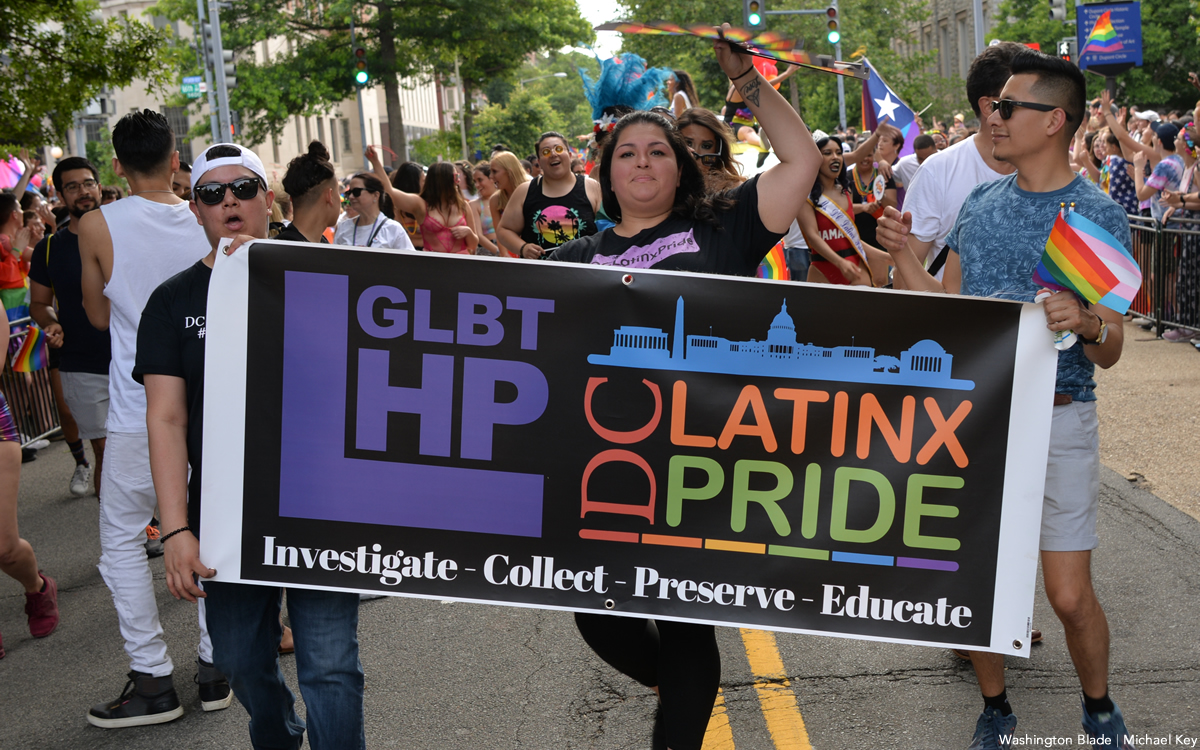
The Latinx History Project will host its 18th annual Latinx Pride with a series of 11 events this year.
Latinx History Project, or LHP, was founded in 2000 to collect, preserve and share Latinx LGBTQ+ History. Six years later, they began hosting DC Latinx Pride.
Board member Dee Tum-Monge said organizers saw a need for the event that centered Latinx community members.
“LHP knows our queer history as Latinx folks has most often been lost to generations of colonialism and imperialism,” they said. “Which is why we focus on documenting and highlighting the impact our community has in D.C. and beyond.”
According to UCLA School of Law, there are more than two million Latinx LGBTQ adults that live in the U.S.
“Events specifically for the Latinx community are important not only to make our experience visible but also to create spaces where we can grow closer with other groups and each other,” said Tum-Monge.
This year they kicked off DC Latinx Pride with a crowning ceremony for their royal court on May 31.
Their three-part series, “La Sanación”, is underway with part two planned for June 16.
“Sanación in Spanish means ‘healing’ which is a big part of what we want to bring to Pride,” said Tum-Monge. “Our communities go through a lot of trauma and hate, but we know there’s more to us. Our goal is to foster connection with ourselves, nature, community, and spirituality.”
In conjunction with the series there is a slate of other events; tickets can be purchased at latinxhistoryproject.org/pride.
In addition, Latinx Pride will march in the Capital Pride Parade on Saturday and participate in the festival on Sunday. To stay involved with Latinx History Project after Pride and hear more about future events visit latinxhistoryproject.org.
-
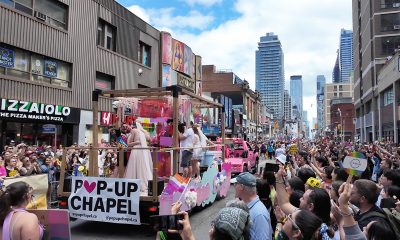
 Canada1 day ago
Canada1 day agoToronto Pride parade cancelled after pro-Palestinian protesters disrupt it
-

 Politics5 days ago
Politics5 days agoLGBTQ issues absent from Trump-Biden debate
-
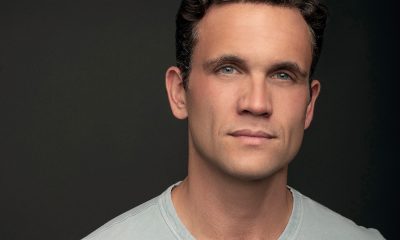
 Theater4 days ago
Theater4 days agoStephen Mark Lukas makes sublime turn in ‘Funny Girl’
-
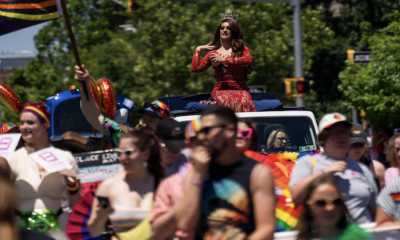
 Baltimore3 days ago
Baltimore3 days agoDespite record crowds, Baltimore Pride’s LGBTQ critics say organizers dropped the ball



